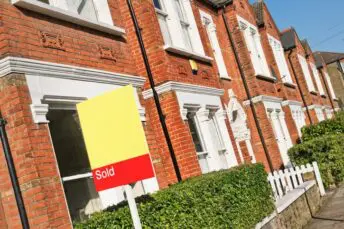House Price Watch May 2022
House price growth remains in double digits this month with an ongoing shortage of homes for sale supporting house prices. However, there are early signs that the market is beginning to cool. Buyer demand fell for the first time in eight months and mortgage activity has come down. Looking ahead, headwinds including the rising cost of living and rising mortgage rates are expected to slow activity and house price growth later this year.
What’s happening nationally
House prices are up on average +1.0% in the past month and +11.4% in the past year.
Indices based on:
Land Registry – registered property transactions in April.
Nationwide & Halifax – mortgage valuations in May.
Rightmove – asking prices posted on Rightmove in May.
*Rightmove is not included in the index average as the basis for its index is different (asking price vs agreed sale price)
| Index reports: | Monthly change | Annual change |
|---|---|---|
| Land registry | +1.1% | +12.4% |
| Nationwide | +0.9% | +11.2% |
| Halifax | +1.0% | +10.5% |
| Rightmove | +2.1% | +10.2% |
| Average change | +1.0% | +11.4% |
House prices in your area
Most areas of the UK have seen house prices up over the past month and double digit house price growth over the past year.
The biggest annual rises in house prices are in Scotland and Wales (+16.2%), The South West (+14.1%) and the North West (+13.3%).
London has experienced the slowest rate of annual house price growth (+7.9%).
Average house prices are highest in London (£530K) and lowest in the North East (£155K).
House price growth also varies by property type. Detached homes have seen the biggest rise (+14.9%) and flats/ maisonettes the smallest (+7.6%) according to Land Registry data. This may reflect regional price differences (more flats in London), as well as, demand – higher demand for bigger properties and fewer properties of this type available for sale over the past year.
| UK Region | Average price £ | Monthly change | Annual change |
|---|---|---|---|
| England | |||
| Nothern Ireland | |||
| Scotland | |||
| Wales | |||
| North West | |||
| Yorkshire and The Humber | |||
| North East | |||
| West Midlands | |||
| East Midlands | |||
| South West | |||
| East of England | |||
| South East | |||
| London |
| UK City | Average price | Annual change |
|---|---|---|
Market Monitor
Transactions have remained above 100K in every month of 2022, higher than pre pandemic levels.
There were 109K transactions in May up 1% on April 2022 (108K). Transactions are down 5% on May 2021 but higher than recent historic levels for this time of year.
First softening of demand in eight months. Stock of homes for sale improves slightly.
Time to sell accelerates.
How busy is the market?
- Not busy
- Normal
- Very busy
- Transactions lower than last May but higher than is typical for time of year
- Total transactions in May 109K
- +1.0% from last month
- -5% lower than May last year
Homes for sale vs homebuyers
- Good availability of homes
- Normal
- Shortage of homes
- Buyer enquiries down (-8% RICS); buyer demand falls for first time in eight months
- Seller enquiries steady (0% RICS)
- Average stock per agent 44; up slightly (incl under offer/ Sold STC Rightmove)
Average speed of sale
- Fast
- Normal
- Slow
- 31 days to find a buyer down from 33 days last month (12 month average 37 days Rightmove)
What the experts say
Rightmove

“People may be wondering why the housing market is seemingly running in the opposite direction to the wider economy at the moment. What the data is showing is that those who have the ability to do so are prioritising their home and moving, and the imbalance between supply and demand is supporting rising prices. Though demand is softening from the heady levels we saw this time last year, the number of buyers enquiring is still significantly higher than during the last ‘normal’ market of 2019, while the number of homes for them to choose from remains more constrained. We anticipate that the effects of the increased cost of living and rising interest rates will filter through to the market later in the year, and a combination of more supply of homes and people weighing up what they can afford will help to moderate the market.”
Nationwide

“House prices posted their tenth successive monthly increase to keep annual house price growth in double-digits. Despite growing headwinds from the squeeze on household budgets due to high inflation and a steady increase in borrowing costs, the housing market has retained a surprising amount of momentum. Demand is being supported by strong labour market conditions, where the unemployment rate has fallen towards 50-year lows. At the same time, the stock of homes on the market has remained low, keeping upward pressure on house prices. We continue to expect the housing market to slow as the year progresses. Household finances are likely to remain under pressure with inflation set to reach double digits in the coming quarters if global energy prices remain high. Measures of consumer confidence have already fallen towards record lows.”
Halifax

“The average cost of buying a home in the UK is up 1%, on last month, and has now risen for eleven consecutive months. Annual growth also remains in double-digits. However, the housing market has begun to show signs of cooling. Mortgage activity has started to come down and, coupled with the inflationary pressures currently exerted on household budgets, it’s likely that activity will start to slow.”
Zoopla (Hometrack)

“Buyer demand remains high but there are now signs that the market is softening, and price growth is set to slow. We expect +3% price growth by the end of 2022. One in twenty properties listed on Zoopla has been re-priced by at least 5% this month. This signals increased buyer resistance to higher prices, and indicates that even amid high levels of demand, price growth may be hitting a natural ceiling.”
RICS

“The May 2022 RICS UK Residential Survey results show a slight drop-off in demand over the month, alongside a generally flat trend being reported for agreed sales and new sales instructions. Further ahead, sentiment around the twelve-month outlook for sales has now weakened in the face of a more challenging macro environment. Despite that, prices are still expected to continue to rise, even if the pace of growth is seen to be moderating.”




